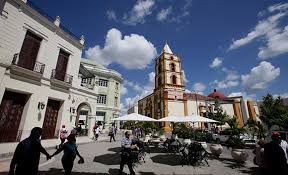 LEYENDAS Y TRADICIONES DE CAMAGÜEY, EL “SANTO SEPULCRO”.
LEYENDAS Y TRADICIONES DE CAMAGÜEY, EL “SANTO SEPULCRO”.
Como tradición la procesión del ‘Santo Sepulcro’ en la cubana ciudad de Camagüey, cada Semana Santa desde el siglo XVIII, deviene en un espectáculo de impresionante belleza y majestuosidad. A su paso, hace recordar la legendaria leyenda de Camagüey, la “Ciudad de las Iglesias”, apelativo conferido y muy difundido en Cuba por la cantidad de los templos de religión católica que posee la añeja villa.
‘El Santo Sepulcro’, obra del orfebre mexicano Don Juan Benítez, realizada por encargo de Don Manuel Agüero y Ortega, se fundió con 25 000 pesos en monedas de plata, rodeada de la leyenda que envuelve su origen. La reliquia constituye la mayor joya de plata pura, única en Cuba y que se exhibe en el templo católico de ‘Nuestra Señora de la Merced’ de la ciudad. La pieza, a la que se le suma el maravilloso tintineo de sus innumerables campanillas, está considerada una de las más valiosas de la América colonial hispana, según los historiadores.
“El Sepulcro había sido dotado de unas campanillas de plata, para que, al ser llevado con un característico paso, lento y ondulante, acompañado por una banda de música con una marcha compuesta al efecto, produjera un delicado sonido. Para la mente popular, estas campanillas tenían un poder especial y podían hasta sanar enfermedades”.
Muchas son las historias que se cuentan alrededor del ‘Santo Sepulcro’, todas envueltas en la mística personalidad del acaudalado hacendado Don Manuel Agüero y Ortega.
En su libro Leyendas y tradiciones del Camagüey, el Dr.Roberto Méndez (Editorial Acana, 2003) refiere detalles que suponen originaron la confección del ‘Santo Sepulcro’ y otras piezas.
Estas leyendas son resumidas en la historia de el hijo mayor de Don Manuel, de igual nombre, este tenia relaciones con una bella mujer de apellido Moya, que por cuestiones todavía no del todo esclarecidas, se enfrasco en un duelo por cuestiones de celos, del que resultó muerto, sin revelar el apellido del asesino, el que luego lleno de remordimiento le confesó a su madre lo ocurrido, y esta a su vez, al protector.
Don Manuel que se había hecho sacerdote en 1749; tiempo después del terrible suceso, destinó a la orden de La Merced la parte de la herencia del hijo asesinado para realizar en el convento un conjunto de obras de arte, entre estas el ‘Santo Sepulcro’, el que donó oficialmente a la iglesia el 9 de febrero de 1763, según consta en documento radicado en el Archivo Provincial de Historia de Camagüey.
Allí solo quedo el Santo Sepulcro como vestigio de aquel pasaje amargo.
El padre decidió entregarse a la paz divina encomendando su riqueza a perpetuar para siempre la terrible leyenda.
 LEGENDS AND TRADITIONS OF CAMAGÜEY, THE “SANTO SEPULCRO”.
LEGENDS AND TRADITIONS OF CAMAGÜEY, THE “SANTO SEPULCRO”.
As a tradition, the procession of the ‘Holy Sepulcher'(Santo Sepulcro) in the Cuban city of Camaguey, every Holy Week since the eighteenth century, becomes a show of impressive beauty and majesty. In its wake, it reminds us of the legendary legend of Camagüey, the “City of Churches”, an appellation conferred and very widespread in Cuba for the number of temples of Catholic religion that the old village has.
‘The Holy Sepulcher’, work of the Mexican goldsmith Don Juan Benítez, commissioned by Don Manuel Agüero y Ortega, was melted with 25,000 pesos in silver coins, surrounded by the legend that surrounds its origin. The relic is the largest pure silver jewel, unique in Cuba and displayed in the Catholic temple of ‘Nuestra Señora de la Merced’ in the city. The piece, to which is added the wonderful tinkling of its innumerable bells, is considered one of the most valuable in Hispanic colonial America, according to historians.
“The Sepulcher had been endowed with some silver bells, so that, being carried with a characteristic step, slow and undulating, accompanied by a band of music with a march composed to the effect, it produced a delicate sound. For the popular mind, these bells had a special power and could even heal diseases. ”
Many are the stories told around the ‘Holy Sepulcher’, all wrapped in the mystical personality of the wealthy landowner Don Manuel Agüero y Ortega.
In his book Legends and traditions of Camagüey, Dr. Roberto Méndez (Editorial Acana, 2003) refers details that suppose originated the preparation of the ‘Holy Sepulcher’ and other pieces.
These legends are summarized in the story of the eldest son of Don Manuel, of the same name, this had relations with a beautiful woman surnamed Moya, who for questions not yet fully clarified, was engaged in a duel on matters of jealousy, who was killed, without revealing the name of the murderer, who then full of remorse confessed to his mother what happened, and this in turn, the protector.
Don Manuel who had become a priest in 1749; After the terrible event, he assigned to the order of La Merced the part of the inheritance of the murdered son to make a set of works of art in the convent, among them the ‘Holy Sepulcher’, which he officially donated to the church on the 9th. February 1763, as recorded in a document filed in the Provincial History Archive of Camagüey.
Only the Holy Sepulcher remained there as a vestige of that bitter passage.
The father decided to surrender to divine peace entrusting his wealth to perpetuate forever the terrible legend.
Agencies/ RHC/ Guadalupe Yaujar/ Maite González/ Extractos/ Internet Photos/ Arnoldo Varona/ www.TheCubanHistory.com
THE CUBAN HISTORY, HOLLYWOOD.










